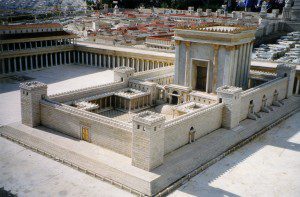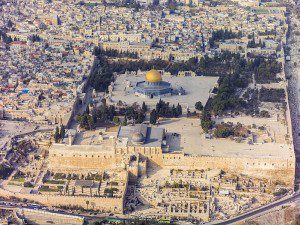
(Click to enlarge. Click again to enlarge further.)
Image from Wikimedia Commons
In Kurt Aland’s Synopsis of the Four Gospels, which I’m using as the structural basis (and the Greek text) for my ongoing commentary, Section 19 (Matthew and Luke’s genealogies of Jesus) is equivalent to Section 6, so, for discussion of those name-lists, I simply call your attention to my previous entry:
http://www.patheos.com/blogs/danpeterson/2014/12/16095.html

(Please do click on the image to enlarge it.)
Photo from Wikimedia Commons
Let’s move on now to a couple of comments — many, many more could be offered! — on the temptation in the wilderness.
The number forty often seems to be connected with a period of testing in the Bible, with a time of trial or probation. Moses, for example, lived for forty years in Egypt and then for forty years in the Sinai desert before he was called to lead the Hebrews out of bondage. Then, he went up onto Mount Sinai for forty days and nights on two separate occasions (Exodus 24:18, 34:1-28), receiving God’s laws. He also sent spies to investigate the land of Canaan for forty days (Numbers 13:25, 14:34).
The prophet Jonah warned Nineveh for forty days that the city would be destroyed if it didn’t repent. The prophet Ezekiel laid on his right side for forty days in order to symbolically represent Judah’s sins (Ezekiel 4:6). Elijah went without food or water for forty days at Mount Horeb. And, of course, in today’s readings Jesus was tempted by the devil during forty days and nights of fasting immediately before the commencement of his ministry. And, later, he’ll appear to his disciples and others for forty days after his resurrection from the dead.
The children of Israel wandered in the wilderness for forty years before a new generation was allowed to possess the promised land. According to Genesis 7:12, the rain of Noah’s flood continued for forty days and forty nights. I suppose that that could also and quite reasonably be considered a time of trial, probation, and testing.
Is forty an accurate or precise number? Maybe. Maybe not. Forty days would be an awfully long time for anybody, even the mortal Jesus, to go without food. It may (think of Ali Baba and his forty thieves) simply be a Middle Eastern colloquialism for “many.” But who knows?
There’s disagreement about what the expression the pinnacle of the temple (τὸ πτερύγιον τοῦ ἱεροῦ) might mean. (πτερύγιον is simply the Greek equivalent of “highest point.”) It could, for example, refer to the very highest point of Herod’s now-long-vanished temple proper, as shown in the first image above. Or, alternatively, it could refer to the southeastern corner of Herod’s great temple platform, still essentially standing today, which, as the Kidron Valley drops off toward the east, looms above the road that skirts it and high above the valley below. (See it in the lower right corner of the second photograph above.)










